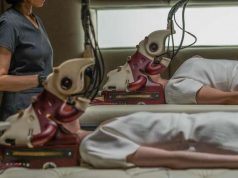Mark my words, one of the coolest, most original and all-out best movies of 2001 will be “Memento.”
Wrap your mind around this concept: A man named Leonard (Guy Pearce) saw his wife murdered, and he was hurt by the killer, too. As a result of the injury, he now has no short-term memory. He can recall everything from before the incident — who he is, his married life, his job as an insurance adjustor — but ever since, his mind can’t create new memories. Every 15 minutes or so, his brain erases like an Etch-a-Sketch, and he has to start over.
He’s trying to find his wife’s murderer — no small feat when your memory resets every few minutes. To keep a handle on what’s going on, he’s developed an intricate way of living. He writes a lot of notes to himself, takes Polaroid pictures of everything (so he can remind himself of basic things like what hotel he’s staying in), and the really important things, he has tattooed on his body. Chief among those items are facts he has learned about the killer (part of his name being most important), and a reminder, written across his chest — backwards, so he can read it in the mirror every morning — that “John G. raped and killed my wife.” When he finds John G., he will kill him.
The film opens with a Polaroid picture slowly fading away. Clever, no, as the film is about diminished memories? Yes, but that’s not it. The picture isn’t fading away at all. Instead, we realize we’re watching the scene go backwards: A fully developed photo is slowly un-developing and then being sucked back up into the camera. It’s the first indication of the movie’s true stroke of genius: It’s told in backwards order.
The first scene is of Leonard shooting John G. in the head, having finally reached his goal. The next scene is what happened to Leonard just before that, ending with about the first 15 seconds of the shooting scene. The whole story is told that way, each scene lasting as long as one of Leonard’s memory spans, and each scene ending with a few seconds of overlap to show us how it leads into the thing that happens next (which, of course, we’ve already seen).
Why is this genius? Because it keeps us in the dark almost as much as Leonard. Just like Leonard, we don’t know what happened before; we only know what’s happening now. We have the advantage, though, because we’re able to add all of these scenes together to form a complete story, which Leonard cannot do.
Which is why the film takes such a dark, deliciously creepy turn. Seeing things progress in reverse order, we can see mistakes Leonard made along the way — mistakes Leonard cannot learn from, as he has no hindsight.
The film plays on the basic human element of trust, both in others and in ourselves. Leonard had trusted a guy named Teddy (Joe Pantoliano), who turns out to be the John G. he shoots in that opening scene. He has written on his photo of Teddy, “Don’t believe his lies,” and he lives by that motto throughout. He also trusts a bar waitress named Natalie (Carrie-Anne Moss), who has also lost a loved one and will help Leonard out of pity, according to her photo caption.
Ultimately, he’s really only trusting himself. When he learns something important — like not to believe Teddy’s lies, for example — he writes it on the photo. When his memory starts over and he has to look at his notes to figure out what he’s doing, all he can do is trust that he knew what he was talking about when he wrote that.
Director Christopher Nolan exhibits an astounding attention to detail, and a watchful viewer is rewarded enormously. Why does Leonard have a scratch on his cheek? Why does Natalie appear to have been beaten up? Leonard often says he’s not good on the phone — he needs to be able to look at people to tell if they’re lying to him — yet in the ongoing scene that is interwoven as a buffer between all the reverse-order scenes, he is on the phone and speaking freely. It all makes sense; I could find no detail that went unexplained. The construction of the film is as close to perfect as anything I’ve seen.
Do our memories play tricks on us? Do we, at least subconsciously, choose our memories? Would we be better off if we were like Leonard, going only by cold, hard facts and not relying on something so subjective as memory? Fantastically taut, crafty and utterly original, “Memento” answers these questions and asks a thousand more. It’s ironic, given the subject matter, but it’s a film you’ll remember for a long time.
A (; )





